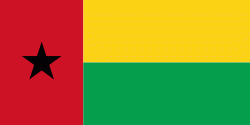Bafatá (Bafata Sector)
Bafatá is a town in central Guinea-Bissau, known as the birthplace of Amílcar Cabral. The town has a population of 22,501 (2008 est). It is the capital of Bafatá Region as well as the seat of the Roman Catholic Diocese of Bafatá, which was established in March 2001 with Carlos Pedro Zilli as bishop.
Bafatá is noted for its brickmaking. By the 1880s it was an established trading centre for the Portuguese, including peanuts, cattle, hides, textiles, and salt.
The town is served by Bafatá Airport, an airstrip, and a regional hospital. There is a hotel, the Bafatá Apartamento Imel. The restaurant Ponto de Encontro serves Portuguese cuisine. The surrounding forests are noted for their monkey and antelope populations, and Maimama Cape, owned by a Cape Verdean, organizes trips to visit the animals for tourists. The town is in a derelict state; the streets contain tumbleweeds and cracked tarmac. Several of the main avenues are named Bissau, Brazil and Guiana.
Bafatá is noted for its brickmaking. By the 1880s it was an established trading centre for the Portuguese, including peanuts, cattle, hides, textiles, and salt.
The town is served by Bafatá Airport, an airstrip, and a regional hospital. There is a hotel, the Bafatá Apartamento Imel. The restaurant Ponto de Encontro serves Portuguese cuisine. The surrounding forests are noted for their monkey and antelope populations, and Maimama Cape, owned by a Cape Verdean, organizes trips to visit the animals for tourists. The town is in a derelict state; the streets contain tumbleweeds and cracked tarmac. Several of the main avenues are named Bissau, Brazil and Guiana.
Map - Bafatá (Bafata Sector)
Map
Country - Guinea-Bissau
 |
 |
| Flag of Guinea-Bissau | |
Guinea-Bissau was once part of the kingdom of Kaabu, as well as part of the Mali Empire. Parts of this kingdom persisted until the 18th century, while a few others were under some rule by the Portuguese Empire since the 16th century. In the 19th century, it was colonised as Portuguese Guinea. Portuguese control was restricted and weak until the early 20th century with the pacification campaigns, these campaigns solidified Portuguese sovereignty in the area. The final Portuguese victory over the remaining bastion of mainland resistance, the Papel ruled Kingdom of Bissau in 1915 by the Portuguese military office Teixeira Pinto, and recruited Wolof mercenary Abdul Injai was the event to solidify mainland control. The Bissagos, islands off the coast of Guinea-Bissau, were officially conquered in 1936, ensuring Portuguese control of both the mainland and islands of the region. Upon independence, declared in 1973 and recognised in 1974, the name of its capital, Bissau, was added to the country's name to prevent confusion with Guinea (formerly French Guinea). Guinea-Bissau has a history of political instability since independence, and only one elected president (José Mário Vaz) has successfully served a full five-year term. The current president is Umaro Sissoco Embaló, who was elected on 29 December 2019.
Currency / Language
| ISO | Currency | Symbol | Significant figures |
|---|---|---|---|
| XOF | West African CFA franc | Fr | 0 |
| ISO | Language |
|---|---|
| PT | Portuguese language |















